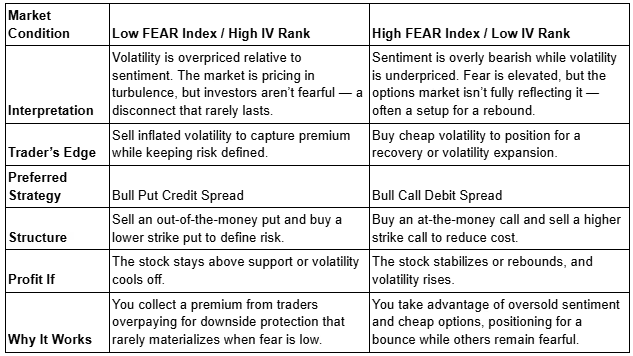Markets move on emotion, and fear is the loudest signal of all. The Fear Index from Trading Central tracks that emotion in real time, letting traders see when anxiety is spiking and when opportunity may be just around the corner.
The TC Fear Index is an AI-driven sentiment tool that tracks millions of news and social posts every hour to spot surges in market anxiety. A reading above 55 flags elevated fear, those moments when emotion takes control and price action disconnects from fundamentals and technicals.
When markets get emotional, price action can turn fast. A fear spike often precedes volatility, breakouts, or reversals. Traders can use the TC FEAR Index to:
The power of the TC Fear Index multiplies when combined with Trading Central’s Options Insight, which tracks real-time changes in implied volatility and market expectations.
Together, they show not just how traders are pricing risk, but how investors feel about it.
For example, Advanced Micro Devices (AMD), a designer and producer of microprocessors, recently displayed a striking disconnect:

Options Insight showed an implied volatility rank of 97, one of its highest readings of the year, meaning options premiums were extremely expensive. Yet the TC FEAR Index tells a very different story, a reading of just 36, well below the caution threshold of 55, shows investor sentiment remains calm and largely unworried.

This disconnect between high implied volatility and low emotional fear is where insight becomes opportunity.
This kind of divergence reveals when volatility is event-driven, not emotion-driven, a key insight for contrarian traders. When volatility is expensive but fear is cheap, it often signals mispriced risk and the potential for volatility compression once the event passes.
The beauty of combining Trading Central’s Options Insight and Fear Index is that they don’t just measure volatility and emotion — together, they help traders decide how to position themselves.
Let’s take AMD’s current setup as an example:
When I see the FEAR Index below 40 and Implied Volatility Rank above 80, it tells me volatility is overpriced relative to sentiment. The market is bracing for turbulence, but the crowd isn’t emotionally fearful — a disconnect that usually doesn’t last. Either volatility collapses, or fear catches up. The edge lies in selling that inflated premium, capturing income while keeping risk contained.
In this scenario, a Bull Put Credit Spread becomes attractive. When implied volatility is high but sentiment remains calm, traders are overpaying for downside protection. I’ll sell an out-of-the-money put and buy a lower strike put to define my risk. The trade profits if the stock stays above support or volatility cools off, allowing me to collect premium from traders paying too much for fear that isn’t there.
Understanding the relationship between Trading Central’s Fear Index and Implied Volatility Rank can help traders align their strategy with market psychology.
Here’s how I approach two very different sentiment setups:

The TC Fear Index turns market psychology into measurable data. When paired with Options Insight, it helps traders see not just what’s happening, but why. The index reveals how investors feel, while Options Insight shows how that emotion is priced through implied volatility. Together, they uncover opportunities others miss — whether it’s selling inflated volatility when fear is low, or buying cheap exposure when panic peaks. It’s a disciplined, data-driven way to align trading decisions with market psychology, and turn sentiment into a measurable edge.